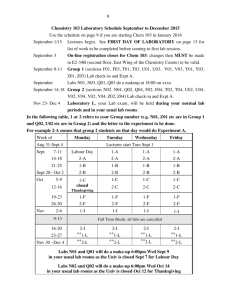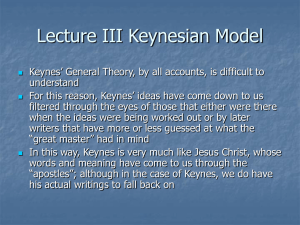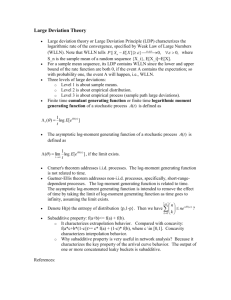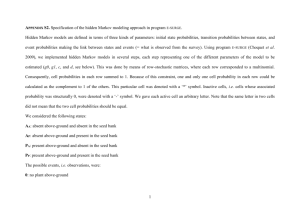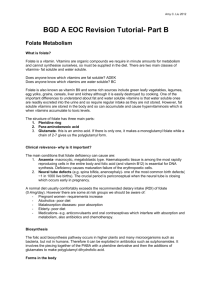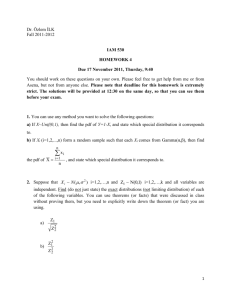7.6
advertisement
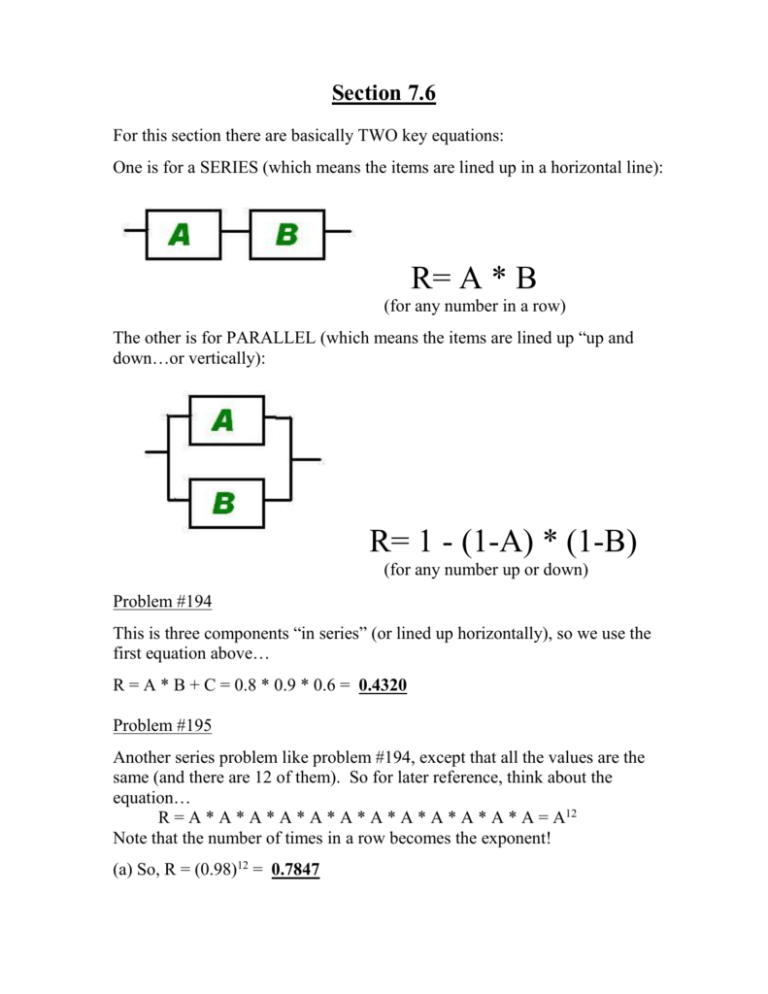
Section 7.6 For this section there are basically TWO key equations: One is for a SERIES (which means the items are lined up in a horizontal line): R= A * B (for any number in a row) The other is for PARALLEL (which means the items are lined up “up and down…or vertically): R= 1 - (1-A) * (1-B) (for any number up or down) Problem #194 This is three components “in series” (or lined up horizontally), so we use the first equation above… R = A * B + C = 0.8 * 0.9 * 0.6 = 0.4320 Problem #195 Another series problem like problem #194, except that all the values are the same (and there are 12 of them). So for later reference, think about the equation… R = A * A * A * A * A * A * A * A * A * A * A * A = A12 Note that the number of times in a row becomes the exponent! (a) So, R = (0.98)12 = 0.7847 (b) This now is a reverse of part (a)…you know the R but not the component value, so the equation looks like…0.98 = X12, so you have to take the 12th root of 0.98 to get X, or X = 0.9983 Problem #196 This problem is similar to problem #195 part (b), but you must use the second equation above (since this is a parallel system). First remember that (just like for series of the same component) that… R = 1 – (1-A) * (1-A) * (1-A) = 1 – (1-A)3 (and likewise for any number in parallel, just change the exponent) (a) So, 0.9 = 1 – (1- 0.6)x subtracting 1 from each side gives you, -0.1 = -(0.4)x then multiplying by -1 gives you, 0.1 = (0.4)x But to solve for x you have two options, either you can use your calculator to guess x until your result is less than 0.1 (in this case), OR you can resort to memorizing a log equation: log 0.1/ log 0.4 (in this case). In either case you will come up with an answer of X = 3 the number MUST be an INTEGER (you cannot have part of a component) (For your reference, log 0.1/log0.4 = 2.5129, so you go up to the next highest integer, if you wish to use this method) (b) This is the same as part (a) except that it is 0.98 rather than 0.9, so, 0.02 = (0.4)x , for this case, which means that X = 5 Problem #197 (a) This is done the same way as part (a) of problem #195, since it is a series. So, R = (0.7)4 = 0.2401 (b) Since this is a parallel system, we use the second equation at the top. R = 1 – (1-0.7)4 = 1 – (0.3)4 = 1 – 0.0081 = 0.9919 (Note the power of reliability for a parallel system over a series system.) Problem #198 A series equation…so plugging the values given into the series equation… R = 0.80 = 0.90 * 0.95 * C or, C = 0.80 / (0.90 * 0.95) = 0.9070 Problem #199 Same as problem #198 except for the value of A: R = 0.80 = 0.80 * 0.95 * C or, C = 0.80 / (0.80 * 0.95) = 1.0526, which is IMPOSSIBLE (It is impossible because no system can have an efficiency of greater than 1.) Problem #200 #200 is given by the following diagram (system): 0.95 0.80 0.95 0.80 0.90 For this problem we cannot calculate using a series because there are 2 parallel elements in the system, so we must first calculate BOTH of the 2 parallel systems FIRST. Going from right to left… and R = 1 – (1 - 0.95) (1 - 0.95) = 1 -0.05*0.05 = 1 – 0.0025 = 0.9975 R = 1 – (1 – 0.80) (1 - 0.80) = 1 -0.20*0.20 = 1 – 0.0400 = 0.9600 With these calculations we can substitute the single number for each parallel system and get the following equivalent diagram/system: 0.90 0.9975 0.96 And this is a simple series calculated by 0.9 * 0.9975 * 0.96 = 0.8618 Problem #201 #201 is given by the following diagram (system): 0.90 0.98 0.99 0.95 For this problem though it looks like a simple parallel system, but unfortunately has 2 elements above 2 elements (and for a parallel it can only have one element above one element). So we must first calculate BOTH of the 2 series systems FIRST. Going from top to bottom… and R = 0.90 * 0.98 = 0.882 R = 0.99 * 0.95 = 0.9405 With these calculations we can substitute the single number for each parallel system and get the following equivalent diagram/system: 0.882 0.9405 And this simple parallel system can be calculated by R = 1 – (1 - 0.882)(1 - 0.9405) = 1 – 0.0070 = 0.9930 Problem #202 #202 is given by the following diagram (system): 0.70 0.90 0.95 0.99 0.70 0.70 0.80 0.70 For this problem though it looks complicated can be broken up into small pieces and simplified. First recognize the pices that can be calculated. I will start with the simple parallel system with two 0.7 elements in it… R = 1 – (1 - 0.7)(1 – 0.7) = 1 – 0.3*0.3 = 1 – 0.09 = 0.91 Now by replacing the parallel system with an equivalent element, you get a system that looks a lot like a parallel system (except that there are four on the top and three on the bottom)… 0.70 0.70 0.90 0.95 0.80 0.99 0.91 So we must first calculate BOTH of the 2 series systems NEXT. Going from top to bottom… and R = 0.70 * 0.90 * 0.95 * 0.99 = 0.592515 R = 0.70 * 0.80 * 0.91 = 0.5096 With these calculations we can substitute the single number for each parallel system and get the following equivalent diagram/system: 0.5925 0.5096 And this simple parallel system can be calculated by R = 1 – (1 - 0.592515)(1 - 0.5096) = 1 – 0.19983 = 0.8002 Problem #203 A series system with “ using back-ups in parallel”, so for each component type (i.e. A, B and C) you have them “stacked” in parallel, but A, B and C components are connected in series…kind of like the system below (which is JUST an example, not the solution): A B C A B C Of course the example only shows 2 of each component, but for the solution it can be any number for each, and the numbers do not have to be the same for all the components. Let’s see how the cost and reliability will change as we increase the numbers for each of the components. (I will use a table.) # of components 2 3 4 Component A Cost: 2*$20 = $40 R = 1 – (1-0.80)2 = 0.96 Cost: 3*$20 = $60 R = 1 – (1-0.80)3 = 0.992 Cost: 4*$20 = $80 R = 1 – (1-0.80)4 = 0.9984 Component B Cost: 2*$10 = $20 R = 1 – (1-0.70)2 = 0.91 Cost: 3*$10 = $30 R = 1 – (1-0.70)3 = 0.973 Cost: 4*$10 = $40 R = 1 – (1-0.70)4 = 0.9919 Component C Cost: 2*$40 = $80 R = 1 – (1-0.90)2 = 0.99 Cost: 3*$40 = $120 R = 1 – (1-0.90)3 = 0.999 Cost: 4*$40 = $160 R = 1 – (1-0.90)4 = 0.9999 The system illustrated as the example would have a reliability of R = 0.96 * 0.91 * 0.99 = 0.8649 , which is less than the required 0.97 reliability (and it costs $40 + $20 + $80 = $140). So how do you change the system such that it gets a reliability of 0.97. First, it must be recognized that when calculating a parallel system, the more components the better the system reliability will become, but for a series reliability the system reliability will be less than the highest component reliability in the series system. So, we must have all the parallel systems ABOVE a reliability of 0.97. Looking at the table above, for A that is when there are 3 or more components; for B it is for 3 or more components; and for C it is for 2 or more components. So let’s see what the result of having the minimum in each of the components that exceed 0.97… R = 0.992 * 0.973 * 0.99 = 0.9556 (not quite enough) Ok, let’s up the B component by one (since we are cost conscience, and that costs the least) and see what that does to our reliability… R = 0.992 * 0.9919 * 0.99 = 0.9741 (it works) And the cost is $60 + $40 + $80 = $180 So the answer is that with 3 A components, 4 B components and 2 C components you have the least expensive system ($180) Problem #204 #204 is given by the following diagram (system): C 0.98 0.97 C To change this system to the following system, you must calculate the reliability for the parallel system with C in it… Rc 0.98 0.97 Which is Rc = 1 – (1-C)2. So the system Reliability becomes (since it is now a series): R = [1 – (1-C)2] * 0.98 * 0.97 Also knowing that the system must have a reliability of 0.94 (from the problem text) this becomes: 0.94 = [1 – (1-C)2] * 0.98 * 0.97 0.988849 = 1 – (1-C)2 -0.0111509 = – (1-C)2 0.0111509 = (1-C)2 0.105598 = 1 - C -0.8944 = -C C = 0.8944 now divide both sides by 0.98*0.97 now subtract 1 from both sides now multiply both sides by -1 now take the square root of both sides now subtract 1 from both sides now multiply both sides by -1 Problem #205 #205 is a revision to #204, but will be done the same way; so the problem is given by the following diagram (system): C 0.99 0.97 C To change this system to the following system, you must calculate the reliability for the parallel system with C in it… Rc 0.99 0.97 Which is Rc = 1 – (1-C)2. So the system Reliability becomes (since it is now a series): R = [1 – (1-C)2] * 0.99 * 0.97 Also knowing that the system must have a reliability of 0.96 (from the problem text) this becomes: 0.96 = [1 – (1-C)2] * 0.99 * 0.97 0.999688 = 1 – (1-C)2 -0.000312 = – (1-C)2 0.000312 = (1-C)2 0.017664 = 1 - C -0.9823 = -C C = 0.9823 now divide both sides by 0.99*0.97 now subtract 1 from both sides now multiply both sides by -1 now take the square root of both sides now subtract 1 from both sides now multiply both sides by -1 With these calculations we can substitute the single number for each parallel system and get the following equivalent diagram/system: And this is a simple series calculated by 0.9 * 0.9975 * 0.96 = 0.8618 Problem #206 #206 is asking which of 2 systems is better…better will be whichever one has the higher reliability). So we start with the reliability of system 1, which looks like: 0.60 0.75 0.60 0.75 We start with evaluating each of the parallel systems separately (going from right to left… R = 1 – (1 – 0.60)2 = 1 – 0.42 = 0.84 R = 1 – (1 – 0.75)2 = 1 – 0.252 = 0.9375 So the system now can be represented as… 0.84 0.9375 So the reliability of System 1 is R = 0.84 * 0.9375 = 0.7875 Now for system 2 which looks like… 0.92 0.92 0.92 0.85 0.60 0.85 Let’s start with the simple parallel part in the lower left… R = 1 – (1 – 0.85)(1 – 0.85) = 1 – 0.15*0.15 = 1 – 0.0225 = 0.9775 With this done the equivalent system looks like… 0.92 0.9775 0.92 0.92 0.60 So now we must calculate BOTH of the 2 series systems NEXT. Going from top to bottom… and R = 0.92 * 0.92 * 0.92 = 0.778688 R = 0.9775 * 0.60 = 0.5865 With these calculations we can substitute the single number for each parallel system and get the following equivalent diagram/system: 0.7786 0.5865 And this simple parallel system can be calculated by (giving System 2 reliability): R = 1 – (1 - 0.778688)(1 - 0.5865) = 1 – 0.0915125 = 0.9085 Comparing the results System 2 is the better system. Problem #207 #207 (a) is given (in words…”an A/B series system that has three B components in a parallel arrangement and one A component”) to look like the following diagram (system): 0.70 0.90 0.70 0.70 To solve this we must first address the parallel system… R = 1 – (1 – 0.70)3 = 1 – 0.33 = 0.973 So the system now can be represented as… 0.90 0.973 So the reliability of this series system is R = 0.90 * 0.973 = 0.8757 #207 (b) is given (in words…”an A/B series system that has four B components in a parallel arrangement and three A components in parallel”) to look like the following diagram (system): 0.90 0.70 0.90 0.70 0.90 0.70 0.70 To solve this we must first address the 2 parallel systems (from right to left)… R = 1 – (1 – 0.90)3 = 1 – 0.13 = 0.999 and R = 1 – (1 – 0.70)4 = 1 – 0.34 = 0.9919 So the system now can be represented as… 0.999 0.9919 So the reliability of this series system is R = 0.999 * 0.9919 = 0.9909 Problem #208 #208 describes a problem in which all the components are in a series, so all the components would simply be multiplied together to get the system reliability: R = 0.9998 * 0.992 = 0.9723 Problem #209 #209 is given by the following diagram (system): 0.65 0.86 0.74 0.65 To change this system to the following system, you must calculate the reliability for the parallel system… R = 1 – (1-0.65)2 = 1 – 0.352 = 0.8775 Giving an equivalent system of… 0.8775 0.86 0.74 Which is solved as a series… R = 0.8775 * 0.86 * 0.74 = 0.5584

